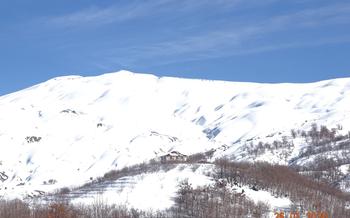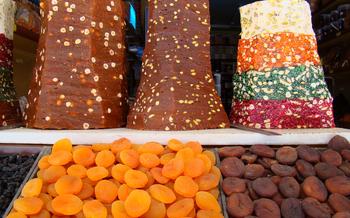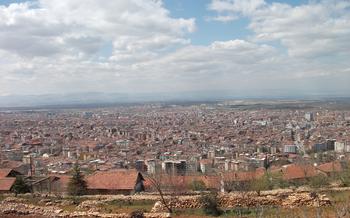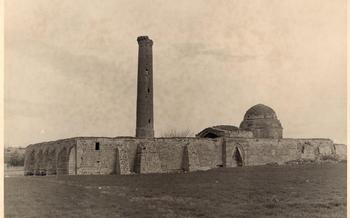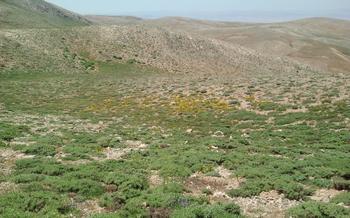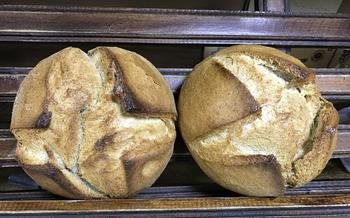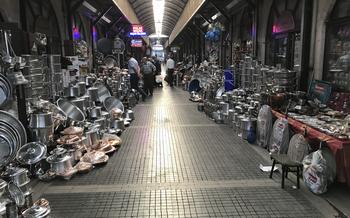
Derviş Ahmed Tomb
- The Derviş Ahmed Tomb: A Historical Gem in Malatya
- Location and Accessibility
- Visiting Hours and Ticket Information
- Exploring the Tomb's Interior
- Surrounding Area and Nearby Attractions
- Historical Significance of Derviş Ahmed
- Architectural Features and Design Elements
- Role in the Region's Cultural Heritage
- Visiting During Religious Festivals
- Practical Tips:
- Local Craftsmanship and Handicrafts: A Glimpse into Malatya's Living Heritage
- Interaction with Locals and Cultural Exchange: Embracing the Warmth of Malatya
- Local Cuisine and Culinary Delights
- Exploring the City of Malatya
- Safety and travel considerations
- Insider Tip: Hidden Gem
The Derviş Ahmed Tomb: A Historical Gem in Malatya
The Derviş Ahmed Tomb, a significant historical and cultural landmark, stands as a testament to the rich heritage of Malatya. Built in the 15th century, this mausoleum is the final resting place of Derviş Ahmed, a revered religious figure and community leader. The tomb's architectural design showcases intricate carvings, delicate ornamentation, and a blend of Seljuk and Ottoman styles, reflecting the region's diverse history.
As a symbol of spiritual devotion and cultural identity, the Derviş Ahmed Tomb holds immense reverence among the local community. Its exquisite craftsmanship and historical significance make it a must-visit attraction for travelers seeking a glimpse into the region's rich past and vibrant religious traditions.
During my visit to the tomb during a religious festival, I witnessed the profound devotion of the local people as they gathered to pay their respects and seek blessings. The atmosphere was charged with a sense of spirituality and reverence, making it an unforgettable experience.
Location and Accessibility
The Derviş Ahmed Tomb is conveniently located in the heart of Malatya, making it easily accessible for visitors. The exact address is Sokak Mahallesi, Ahmetpaşa Caddesi No:82, 44080 Merkez/Malatya. To reach the tomb, you can use the following GPS coordinates: 3351184, 331398
Public Transportation
If you prefer to use public transportation, there are several bus lines that stop near the tomb. The most convenient option is to take bus number 13, which departs from the central bus station and stops right in front of the tomb.
Private Vehicle
For those traveling by private vehicle, there are ample parking options available in the vicinity of the tomb. There are several designated parking lots within walking distance, ensuring that you can easily find a spot to leave your car.
Practical Tips
- When visiting the tomb by car, be mindful of the narrow streets and traffic in the area.
- For a hassle-free visit, consider arriving early in the morning or later in the afternoon to avoid crowds.
- The tomb is located in a residential neighborhood, so please be respectful of the local residents and their privacy.
Visiting Hours and Ticket Information
The Derviş Ahmed Tomb is open to visitors daily from 9 am to 5 pm. The visiting hours may vary slightly during the off-season or on religious holidays, so it's advisable to check in advance.
Admission to the tomb is free of charge. However, donations are welcome and help maintain the site's upkeep and preservation. Guided tours are not currently available, but there are informative signs and brochures that provide insights into the tomb's history and significance.
Insider Tip:
To avoid crowds and have a more immersive experience, plan your visit during the weekdays or early mornings. The tomb is relatively quiet during these times, allowing you to explore at your own pace and soak in the spiritual atmosphere.
Exploring the Tomb's Interior
The Derviş Ahmed Tomb unveils its secrets as visitors step inside its hallowed halls. The layout is simple yet awe-inspiring, inviting contemplation and reverence. A cenotaph, the symbolic representation of Derviş Ahmed's final resting place, occupies the center stage. Its intricate carvings and calligraphy narrate tales of his life and teachings, capturing the essence of his spiritual journey.
The tomb's walls are adorned with verses from the Quran, each stroke meticulously etched, reflecting the profound respect and devotion held for Derviş Ahmed. The inscriptions, like whispers from the past, transport visitors to a time when his words resonated throughout the region, shaping the hearts and minds of his followers.
Every corner of the tomb exudes a sense of history and spirituality. The air is palpable with the presence of those who came before, seeking solace, guidance, and inspiration within these walls. The tomb stands as a testament to the enduring legacy of Derviş Ahmed, a man whose teachings continue to resonate across generations.
As I stood in the tomb's tranquil embrace, I felt a profound connection to the past. The silence was broken only by the gentle echoes of my footsteps, as if the tomb itself were sharing its stories with me. It was a moment of profound peace and reflection, a reminder of the enduring power of faith and the indelible mark it leaves on our world.
Surrounding Area and Nearby Attractions
When exploring the area surrounding the Derviş Ahmed Tomb, you will find a treasure trove of historical sites, museums, and landmarks inviting you to delve deeper into the region's rich heritage. For a comprehensive cultural experience, visit the Malatya Museum, home to an impressive collection of artifacts that narrate the city's captivating history. Step into the enchanting world of the Malatya Bazaar, where vibrant colors and exotic aromas fill the air as locals go about their daily lives.
Indulge in the flavors of traditional cuisine at nearby restaurants, where you can savor delicious dishes that showcase the region's culinary delights. Treat your palate to the famous Malatya apricots, a sweet and succulent fruit that is a local specialty. As the sun sets, immerse yourself in the vibrant atmosphere of local festivals and events that celebrate the region's unique cultural identity. These events offer a fascinating glimpse into the customs and traditions of the local people.
Practical tip: To make the most of your visit, plan your trip to coincide with the annual Apricot Festival held in Malatya. This lively event showcases the region's renowned apricots and features a variety of cultural performances, exhibitions, and competitions that highlight the rich heritage of the area.
Historical Significance of Derviş Ahmed
Derviş Ahmed, the namesake of the revered tomb in Malatya, was a prominent religious figure and community leader who left an indelible mark on the region's history and culture. Born in the 15th century, he dedicated his life to spreading Islamic teachings and promoting spiritual growth among his followers.
As a revered spiritual guide, Derviş Ahmed attracted a vast following due to his wisdom, compassion, and unwavering dedication to his community. His teachings emphasized the importance of love, tolerance, and unity, which resonated deeply with the hearts of those who sought his guidance.
Beyond his spiritual influence, Derviş Ahmed also played a crucial role in fostering social and cultural development in Malatya. He established educational institutions and centers of learning, contributing to the intellectual and scholarly growth of the region. His efforts to promote knowledge and education left a lasting legacy that continues to shape the cultural fabric of Malatya.
Architectural Features and Design Elements
The Derviş Ahmed Tomb stands as a testament to the region's rich architectural heritage, showcasing a blend of Seljuk and Ottoman influences. Constructed using locally sourced stone, the tomb's exterior exudes a sense of solidity and permanence. Its octagonal base is adorned with intricate carvings and decorative elements, reminiscent of the Seljuk architectural style. The tomb's most striking feature is its conical roof, topped with a decorative finial, which adds a touch of elegance to the overall design. The tomb's interior is equally impressive, featuring a beautifully carved cenotaph, adorned with intricate patterns and inscriptions. The walls are lined with colorful tiles, each tile telling a unique story from the life of Derviş Ahmed. These tiles, along with the finely crafted wooden panels, create a visually stunning and spiritually uplifting atmosphere within the tomb.
Role in the Region's Cultural Heritage
The Derviş Ahmed Tomb holds immense cultural and religious significance for the people of Malatya. It serves as a symbol of the region's rich history and spiritual heritage. The tomb is not merely a mausoleum; it's a place of reverence, where locals pay their respects and seek blessings. Throughout the year, various religious ceremonies and events are held at the tomb, attracting devotees from near and far. These gatherings foster a sense of community and strengthen the bonds of faith among the believers. The tomb's presence has significantly contributed to the cultural identity of Malatya, making it an integral part of the city's heritage.
Insider tip: During the annual Urs festival, which celebrates the anniversary of Derviş Ahmed's passing, the tomb becomes a hub of spiritual fervor. Devotees from across the region flock to the tomb to participate in prayers, recitations, and traditional rituals. It's a truly immersive experience that showcases the depth of devotion and the vibrant spiritual traditions of the local community. If you happen to be in Malatya during this time, don't miss the opportunity to witness this extraordinary event.
Visiting During Religious Festivals
The Derviş Ahmed Tomb comes alive during religious festivals, transforming into a vibrant hub of devotion and cultural expression. The most significant celebration is the annual Urs, a multi-day event held in honor of the saint's death anniversary. During this time, the tomb becomes a focal point for pilgrims and visitors from across the region.
The atmosphere during the Urs is electric, filled with the sounds of prayers, recitations, and devotional music. The tomb's interior is adorned with colorful decorations, and the air is thick with the scent of incense and rosewater. Pilgrims gather to pay their respects, offer prayers, and seek blessings from Derviş Ahmed.
Visitors can witness traditional ceremonies and rituals performed by local religious leaders. Dervishes perform whirling dances, accompanied by rhythmic music and chanting. These dances are a form of spiritual expression, symbolizing the connection between the earthly and divine realms.
Attending the Urs is an immersive experience that allows visitors to delve into the rich cultural and religious traditions of Malatya. It's an opportunity to witness the deep devotion and reverence held for Derviş Ahmed and to gain a deeper understanding of his teachings and legacy.
Practical Tips:
- Dress appropriately: Visitors should dress modestly and respectfully, covering their shoulders and knees.
- Respect local customs: Be mindful of local customs and traditions, such as removing shoes before entering the tomb.
- Photography: Photography is generally allowed, but it's important to be respectful and avoid taking photos during prayers or ceremonies.
- Local guides: Consider hiring a local guide to provide insights into the festival's rituals and traditions.
Local Craftsmanship and Handicrafts: A Glimpse into Malatya's Living Heritage
Malatya, with its rich cultural heritage, is renowned for its exquisite traditional crafts and handicrafts. The city has a long history of craftsmanship, with artisans passing down their skills and techniques from generation to generation. Visitors can find workshops and bazaars throughout Malatya, where they can observe artisans at work and purchase unique handmade goods.
One of the most famous crafts in Malatya is coppersmithing. Local artisans transform sheets of copper into intricate cookware, decorative items, and jewelry. The coppersmiths' skillful hands create beautiful designs, often incorporating traditional motifs and patterns. Visitors can watch the artisans work and purchase unique copper pieces as souvenirs or gifts.
Another notable craft in Malatya is carpet weaving. The region is known for its high-quality carpets, which are hand-woven using traditional techniques. The carpets are made from natural materials such as wool and cotton, and feature vibrant colors and intricate designs. Visitors can find a wide variety of carpets to choose from, each one telling a unique story of the region's textile heritage.
In addition to coppersmithing and carpet weaving, Malatya is also known for its pottery, wood carving, and textile arts. Visitors can find a variety of handmade goods, including ceramics, wooden ornaments, and embroidered textiles. These crafts not only showcase the skill and artistry of local artisans but also provide a glimpse into the cultural heritage of the region.
Supporting local artisans and purchasing their handmade goods is a meaningful way to contribute to the preservation of Malatya's cultural heritage. By doing so, visitors can take home a piece of the city's living history and support the local economy.
Interaction with Locals and Cultural Exchange: Embracing the Warmth of Malatya
Immerse yourself in the rich culture of Malatya by engaging with the friendly locals. Strike up conversations at local markets, cafes, and shops to gain insights into their daily lives and traditions. Learn a few basic Turkish phrases to show respect and facilitate communication. Attend local events, festivals, and celebrations to experience the vibrant energy and hospitality of the community. Respect local customs and dress codes to avoid misunderstandings and show your appreciation for their culture.
One memorable encounter I had was with a local artisan named Mehmet, who invited me to his workshop to learn about traditional copper craftsmanship. He showed me the intricate process of creating beautiful handmade copperware, from shaping the metal to adding intricate designs. As we worked together, we shared stories and laughter, and I gained a deep appreciation for the skill and artistry involved in his craft.
Embrace the opportunity to connect with the locals of Malatya and create lasting memories. Their warmth and hospitality will make your visit even more enriching and unforgettable.
Local Cuisine and Culinary Delights
Malatya's culinary scene is a tantalizing tapestry of flavors and aromas, showcasing the region's rich cultural heritage. Among the must-try local dishes is "kayısı dolması," a delightful appetizer consisting of dried apricots stuffed with a savory mixture of ground beef, rice, and herbs. These morsels are then simmered in a tangy tomato sauce, creating a harmonious blend of sweet and savory flavors.
For a hearty main course, indulge in "Malatya mantısı," delicate dumplings filled with a flavorful combination of ground lamb, onions, and spices. These dumplings are traditionally served with a yogurt sauce, garlic, and a generous sprinkling of paprika, creating a dish that is both comforting and utterly delicious.
No culinary exploration of Malatya is complete without savoring the local "cevizli sucuk." This unique sweet treat is made from walnuts strung together on a thread and coated in thick, sweet grape molasses. The result is a chewy, nutty confection that is sure to satisfy your sweet tooth.
To fully immerse yourself in the local culinary culture, venture into the bustling markets of Malatya. Here, you'll find an array of fresh produce, fragrant spices, and traditional sweets. Engage with the friendly vendors, sample local delicacies, and take home a piece of Malatya's culinary heritage.
As you savor the local cuisine, remember that food is more than just sustenance in Malatya. It's a way of life, a celebration of the region's rich history and vibrant culture. So, come hungry, come curious, and prepare to embark on a culinary adventure that will leave your taste buds tingling with delight.
Exploring the City of Malatya
Beyond the Derviş Ahmed Tomb, the city of Malatya offers an array of attractions for curious travelers. Delve into the depths of history at the Malatya Museum, home to artifacts that narrate the city's rich past. For a glimpse into local traditions, wander through the vibrant Old Town, where centuries-old buildings line cobblestone streets, exuding an enchanting aura.
Indulge in a shopping spree at the bustling markets, where you can find everything from handmade crafts to fresh produce. Sample the delectable flavors of Malatya's cuisine at local restaurants, savoring specialties like kayısı dolması (stuffed apricots) and the renowned Malatya apricot jam.
For a taste of nature's splendor, escape to the scenic parks and gardens that dot the city. Breathe in the fresh air and marvel at the stunning views from the summit of Mount Nemrut, a natural wonder that offers panoramic vistas of the surrounding landscape.
Malatya's cultural calendar is brimming with events and festivals that showcase the city's vibrant spirit. Immerse yourself in the infectious energy of the Apricot Festival, where the city celebrates its most famous fruit with parades, traditional music, and lively performances.
Whether you seek historical treasures, culinary delights, or simply the joy of exploring a new city, Malatya has something to offer every traveler. Embrace the warmth of its people, soak in the rich cultural heritage, and create lasting memories in this captivating destination.
Safety and travel considerations
Malatya is generally a safe city for travelers, but as with any destination, it's essential to be aware of your surroundings and take reasonable precautions. Here are some safety tips to consider:
-
Dress conservatively and respectfully, especially when visiting religious sites or conservative neighborhoods.
-
Avoid walking alone at night, particularly in poorly lit areas.
-
Be cautious of pickpockets and petty theft in crowded places.
-
Keep your valuables safe and secure, and avoid carrying large amounts of cash.
-
Learn a few basic Turkish phrases and customs to communicate effectively with locals.
-
Respect local traditions and customs, and be mindful of religious sensitivities.
-
If you're traveling during the off-season, be prepared for fewer crowds but also reduced services and attractions.
-
For solo travelers, consider joining group tours or activities to meet other travelers and ensure your safety.
Insider Tip: Hidden Gem
Beyond the Derviş Ahmed Tomb, Malatya holds a hidden gem that offers an authentic glimpse into the region's rich cultural heritage. Nestled amidst the scenic landscapes, the Arslantepe Mound stands as a testament to ancient civilizations. This archaeological site dates back to the 5th millennium BC and was once a thriving settlement of the Neo-Hittite kingdom.
Excavations have revealed impressive remnants of a fortified city, including the majestic Arslantepe Palace. Intricate carvings, sculptures, and artifacts unearthed from the site offer a fascinating glimpse into the lives and beliefs of its ancient inhabitants. The Arslantepe Museum, located nearby, houses an exceptional collection of these artifacts, providing a deeper understanding of the mound's significance.
Visiting Arslantepe Mound is like stepping back in time. As you explore its ancient ruins, you can't help but feel a sense of awe and wonder at the ingenuity and craftsmanship of our ancestors. Whether you're a history buff, an archaeology enthusiast, or simply someone who appreciates hidden gems, Arslantepe Mound is a must-visit destination in Malatya.
